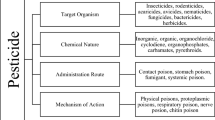Abstract
Bacteria that can degrade juglone (5-hydroxy-1,4-naphthoquinone) were isolated from soil beneath black walnut trees. Autecological studies with one of these bacteria (Pseudomonas J1), demonstrated that it could grow rapidly using juglone as its sole source of carbon and energy. Using nonlinear regression analysis and the Monod equation, it was determined that this bacterium had a high affinity for juglone (K s = 0.95 μg/ml).Pseudomonas J1 can also utilize other aromatic compounds from plants as its sole source of carbon and energy. Compounds such as chlorogenic acid, ferulic acid, gallic acid, and 2-hydroxy-1,4-naphthoquinone (Lawson) were rapidly degraded byPseudomonas J1. The rapid degradation of juglone and other suspected allelochemicals by soil bacteria make it unlikely that these compounds are important mediators of plant-plant interactions under natural conditions.
Similar content being viewed by others
References
Alexander, M. 1977. Introduction to Soil Microbiology. John Wiley & Sons, New York, pp. 214–221.
Balba, M.T.M., Clarke, N.A., andEvans, W.C. 1979. The methanogenic fermentation of plant phenolics.Biochem. Soc. Trans. 7:1115–1116.
Bard, Y. 1974. Nonlinear Parameter Estimation. Academic Press, New York.
Davis, E.F. 1928. The toxic principle ofJuglans nigra as identified with synthetic juglone and its toxic effects on tomato and alfalfa plants.Am. J. Bot. 15:620 (abstract).
Dawson, J.O., andSeymour, P.E. 1983. Effects of juglone concentration on growthin vitro ofFrankia Arl3 andRhizobium japonicum strain 71.J. Chem. Ecol. 9:1175–1183.
Fisher, R.F. 1978. Juglone inhibits pine growth under certain moisture regimes.Soil Sci. Soc. Am. J. 42:801–803.
Fisher, R.F. 1987. Allelopathy: A potential cause of forest regeneration failure, pp. 176–184,in G.R. Waller (ed.). Allelochemicals: Role in Agriculture and Forestry. American Chemical Society Symposium 330. American Chemical Society, Washington, D.C.
Gomez-Alarcon, R.A., O'dowd, C., Leedle, J.A.Z., andBryant, M.P. 1982. 1,4-Naphthoquinone and other nutrient requirements ofSuccinivibrio dextrinosolvens.Appl. Environ. Microbiol. 44:346–350.
Heimbrook, M.E.,Wang, W.L.L., andCampbell, G. 1986. Easily made flagella stains.Abst. Ann, Meeting Am. Soc. Microbiol. p. 240.
Holder-Franklin, M.A., andTate, R.L. 1986. Introduction of the computer into autecological studies, pp. 75–91,in R.L. Tate (ed.). Microbial Autecology, A Method for Environmental Studies. John Wiley & Sons, New York.
Kaminsky, R. 1981. The microbial origin of the allelopathic potential ofAdenosloma fasciculatum H & A.Ecol. Monogr. 51:365–382.
Lockwood, J.L., andFilonow, A.B. 1981. Responses of fungi to nutrient-limiting conditions and to inhibitory substances in natural habitats.Adv. Microbial Ecol. 5:1–61.
Martin, J.P., andHaider, K. 1979. Biodegradation of14C-labeled model and cornstock lignins, phenols, model phenolase humic polymers, and fungal melanins as influenced by a readily available carbon source and soil.Appl. Environ. Microbiol. 38:283–289.
Mathur, S.P. 1972. Spectroscopic and chemical evidence of quinones in soil humus.Soil. Sci. 113:136–139.
Morbland, D.C., andMoreland, R.E. 1975. Soil survey of Boulder County area, Colorado. USDA Soil Conservation Service and Colorado Agricultural Experiment Station, p. 19.
Palleroni, N.J. 1984.Pseudomonas Migula 1894, pp. 141–199,in J.G. Holt and N.R. Krieg (eds.). Bergey's Manual of Determinative Bacteriology, 9th ed., Vol. 1. Williams & Wilkins, Baltimore.
Parke, D., andOrnston, L.N. 1984. Nutritional diversity of Rhizobiaceae revealed by auxanography.J. Gen. Microbiol. 130:1743–1750.
Reber, H. 1975. Investigation of the sequential degradation of aromatic substances in pseudomonads, pp. 466–469,in G. Kilbertus, O. Reisinger, A. Mourey, and J.A. Cancela Da Fonseca (eds.). Biodégradation et Humification. Sarreguémines, Pierron, France.
Rice, E.L. 1984. Allelopathy, 2nd ed. Academic Press, New York.
Rietveld, W.J. 1983. Allelopathic effects of juglone on germination and growth of several herbaceous and woody species.J. Chem. Ecol. 9:295–308.
Rietveld, W.J., Schlesinger, R.C., andKessler, K.J. 1983. Allelopathic effects of black walnut on European black alder coplanted as a nurse species.J. Chem. Ecol. 9:1119–1133.
Rosazzo, J.P. 1982. Microbial Transformation of Bioactive Compounds, Vol. II. CRC Press, Boca Raton, Florida, pp. 25–26.
Saiz-Jimenez, C., Haider, K., andMartin, J.P. 1975. Anthroquinone and phenols as intermediates in the formation of dark-colored humic acid-like pigments byEurotium echinulatum.Soil Sci. Soc. Am. J. 39:649–653.
Schmidt, S.K., Alexander, M., andShuler, M.L. 1985a. Predicting threshold concentrations of organic substrates for bacterial growth.J. Theor. Biol. 114:1–8.
Schmidt, S.K., Simkins, S., andAlexander, M. 1985b. Models for the kinetics of biodegradation of organic compounds not supporting growth.Appl. Environ. Microbiol. 50:323–331.
Schmidt, S.K., Scow, K.M., andAlexander, M. 1987. Kinetics ofp-nitrophenol mineralization by aPseudomonas sp.: Effects of second substrates.Appl. Environ. Microbiol. 53:2617–2623.
Scow, K.M., Simkins, S., andAlexander, M. 1986. Kinetics of mineralization of organic compounds at low concentrations in soil.Appl. Environ. Microbiol. 51:1028–1035.
Simkins, S., andAlexander, M. 1984. Models for mineralization kinetics with the variables of substrate concentration and population density.Appl. Environ. Microbiol. 47:1299–1306.
Smith, O.L. 1982. Soil Microbiology: A Model of Decomposition and Nutrient Cycling. CRC Press, Boca Raton, Florida, pp. 125–146.
Steelink, C., andTollin, G. 1967. Free radicals in soil, pp. 147–169,in A.D. McLaren and G.H. Peterson, (eds.). Soil Biochemistry. Marcel Dekker, New York.
Suflita, J.M., Horowitz, A., Shelton, D.R., andTiedje, J.M. 1982. Dehalogenation: A novel pathway for the anaerobic biodegradation of haloaromatic compounds.Science 218:1115–1117.
Thomson, R.H. 1971. Naturally Occurring Quinones. Academic Press, London, pp. 203–205.
Turner, J.A., andRice, E.L. 1975. Microbial decomposition of ferulic acid in soil.J. Chem. Ecol. 1:41–58.
Williams, R.J., andEvans, W.C. 1975. The metabolism of benzoate byMoraxella species through anaerobic nitrate respiration.Biochem. J. 148:1–10.
Young, L.Y. 1984. Anaerobic degradation of aromatic compounds, pp. 487–523,in D.T. Gibson (ed.). Microbial Degradation of Organic Compounds. Marcel Dekker, New York.
Author information
Authors and Affiliations
Rights and permissions
About this article
Cite this article
Schmidt, S.K. Degradation of juglone by soil bacteria. J Chem Ecol 14, 1561–1571 (1988). https://doi.org/10.1007/BF01012522
Received:
Accepted:
Issue Date:
DOI: https://doi.org/10.1007/BF01012522




